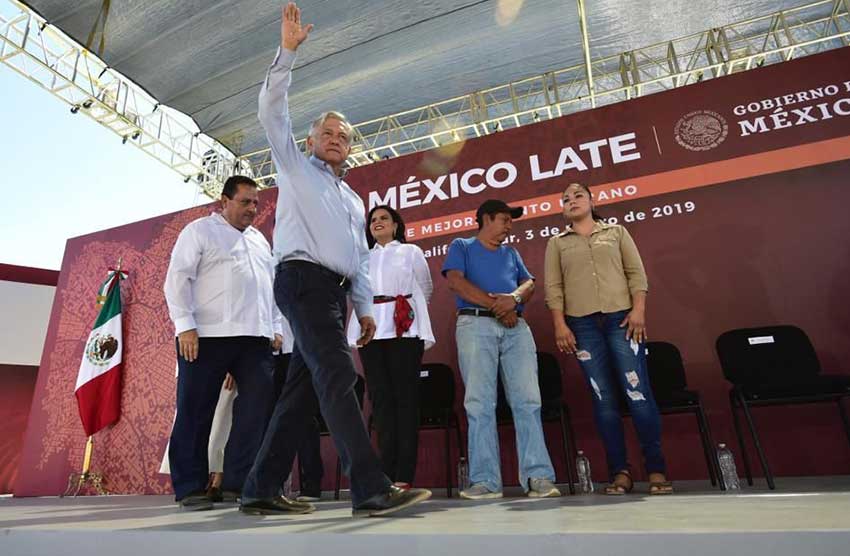8-billion-peso infrastructure program announced for leading tourism destinations
by Mexico News Daily
Putting an end to the “offensive” contrast between luxurious hotels and poor neighborhoods in Mexico’s most popular resort cities is the aim of a new government program launched yesterday by President López Obrador.
The central objective of the Mi México Late (My Mexico Beats) program is to build much-needed infrastructure in the working-class neighborhoods of Mexico’s leading tourism destinations.
“We no longer want there to be the offensive contrast between large hotels and marginalized, impoverished neighborhoods without water services, without drainage, without anything,” López Obrador said yesterday in Los Cabos, Baja California Sur.
Among the cities that will benefit from the 8-billion-peso (US $413.7-million) urban improvement program are Los Cabos, Cancún, Acapulco and Puerto Vallarta.
Urban Development Secretary Román Meyer Falcón said that 10 northern border cities will also receive funding for infrastructure projects through the same program.
López Obrador said the government chose to launch the program in Los Cabos because of its importance to tourism in the country.
Almost 600 million pesos (US $31 million) will be allocated to infrastructure projects in the city’s neighborhoods, he said, explaining that residents will also be able to access financial support in order to obtain deeds for their properties.
The president also said that a 1-billion-peso (US $51.7-million) water desalination plant has been authorized for the area.
López Obrador pledged to return to Los Cabos in a few months to assess the progress of the Mi México Late program and other government initiatives.
“Mexico has a lot of natural resources, a lot of wealth, good people, hard-working people. What was needed, we now have: a good government,” he said.
Meanwhile, López Obrador announced today that his government is planning to launch a tidy towns contest to encourage people to take more pride in the places where they live.
“We have to take care of the cleanliness of our towns … no to garbage, no to dirtiness . . . [societal] transformation also implies cleanliness,” he said.
After waxing lyrical about the beauty of the bougainvillea plant, the president explained that the cleanest, best-decorated towns in Mexico will be officially recognized at an awards ceremony at the National Palace.
A public infrastructure project that each winning town needs will also probably be part of the prize package, López Obrador said.
“There are very poor towns with humble people but they’re very clean. For example, I know all the municipalities of Oaxaca and they’re very clean, they’re careful not to contaminate the water, there are signs … so that people don’t throw detergent and fertilizer into the streams, there are trash cans, that is also very important.”
In other tourism news in Mexico:
Hospitality-travel firm says tourists with money are going elsewhere
Head of Apple Leisure Group says insecurity, sargassum and insufficient marketing are the causes
Mexico’s high-end tourism market has taken a hit so far in 2019, according to the CEO of a hospitality-travel firm who predicts that visitor numbers will decline further in coming months.
Alejandro Zozaya, CEO of Apple Leisure Group, estimates that the economic spillover from tourism is down 20 percent to date this year compared to the same period of 2018.
The problem: not as many wealthy Americans are coming to Mexico to vacation, get married at lavish ceremonies and honeymoon.
“The most important market we have lost is that which leaves the largest economic spillover, the high-end North American,” Zozaya told the news outlet Aristegui Noticias.
“We still have a lot of Americans but the highest segment [of the market] has stopped coming and we’ve replaced them with tourists from other countries and regions who leave a smaller spillover – they spend less at the destination, hotel rates go down,” he said.
The businessman claimed that the main reason well-off tourists are not coming to Mexico is insecurity but added that sargassum on Caribbean coast beaches and a lack of marketing following the government’s decision to disband the Tourism Promotion Council (CPTM) are also factors.
More United States citizens are traveling outside their country than ever before and there is not a decline in the international tourism market, but tourists are deciding to “go to other destinations that are not Mexico,” Zozaya said.
“[Americans] are going to the Dominican Republic, Costa Rica, Jamaica, and Mexico loses market share.”
He said that tourism is declining in Mexico’s most popular destinations at the same as the number of hotel rooms is going up.
“We have 30,000 additional rooms projected for Quintana Roo on top of those in Puerto Vallarta, in Los Cabos and other destinations in Mexico,” Zozaya said.
He stressed that advertising is the best way to attract greater visitor numbers to Mexico and that demand for accommodation and other tourism services must grow at a rate at least equal to supply growth in order to maintain profitability and employment in the sector.
Zozaya’s estimate of a 20 percent reduction in tourism spending this year is well above the 0.3 percent decline in air arrivals recorded in January but the businessman warned that “the most complicated” period for the tourism industry “is still to come.”
Contributing to the decline in international air arrivals in January was a reduction in the number of passengers flying into Cancún International Airport, the first year-over-year decrease for any month in almost seven years.
Earlier this year, the Secretariat of Tourism predicted that international visitor numbers could hit 43.6 million in 2019, which would represent a 5.2 percent increase on last year’s record figures.
Total tourism expenditure is forecast to reach just under US $23.7 billion, which would also be 5.2 percent higher than in 2018.
Last month, Tourism Secretary Miguel Torruco Marqués said the government is aiming to increase expenditure by tourists in Mexico by focusing more on attracting big spenders.
Among the nationalities that spend the most while visiting Mexico, the Japanese are in first place, spending an average of $2,008, not including airfare.
Source: Aristegui Noticias (sp.



